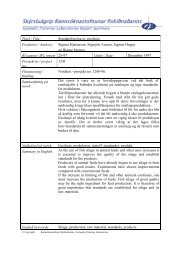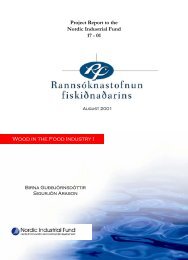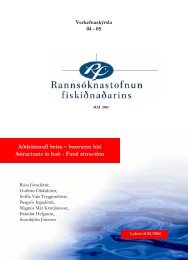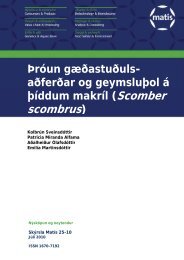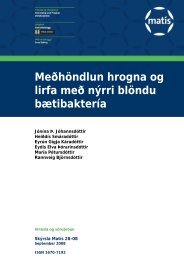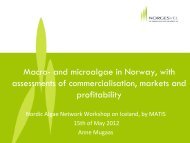Microbiology and Spoilage Trail in Nile Perch (Lates niloticus), Lake ...
Microbiology and Spoilage Trail in Nile Perch (Lates niloticus), Lake ...
Microbiology and Spoilage Trail in Nile Perch (Lates niloticus), Lake ...
Create successful ePaper yourself
Turn your PDF publications into a flip-book with our unique Google optimized e-Paper software.
NH3 Ammonia am<strong>in</strong>o acids <strong>and</strong> urea<br />
Acetate, CO2 (carbon dioxide), H2O<br />
(Water)<br />
14<br />
carbohydrate <strong>and</strong> lactate<br />
Esters, ketones, aldehydes am<strong>in</strong>o-acids (glyc<strong>in</strong>e, ser<strong>in</strong>e, leuc<strong>in</strong>e)<br />
2.3.2 Biochemical spoilage of fresh fish<br />
Fish is very perishable, high prote<strong>in</strong> food which conta<strong>in</strong>s high level of am<strong>in</strong>o acids. Total<br />
volatile basic am<strong>in</strong>es (TVBA), a general term which <strong>in</strong>cludes trimethylam<strong>in</strong>e,<br />
dimethylam<strong>in</strong>e, ammonia <strong>and</strong> other total volatile basic nitrogenous (TVB-N) are<br />
compounds associated with seafood spoilage. The levels of TVB-N <strong>and</strong> TMAO are<br />
different from each fish species <strong>and</strong> even <strong>in</strong> different parts of the fish. The TVB-N consists<br />
of ammonia (NH3), monomethylam<strong>in</strong>e (MMA), dimethylam<strong>in</strong>e (DMA), <strong>and</strong><br />
trimethylam<strong>in</strong>e (TMA). Their levels may change dur<strong>in</strong>g bacterial activity <strong>and</strong> or enzymic<br />
degradation of trimethylam<strong>in</strong>e oxide (TMAO) <strong>in</strong> fish. Mar<strong>in</strong>e fish <strong>and</strong> some freshwater fish<br />
conta<strong>in</strong> trymethylam<strong>in</strong>e oxide (TMAO) which is degraded by majority of spoilage microbes<br />
to trimethylam<strong>in</strong>e (TMA). The SSOs utilizes the available TMAO <strong>in</strong> anaerobic respiration<br />
<strong>and</strong> produces off-odours <strong>and</strong> off-flavours follow<strong>in</strong>g the formation of TMA, (Huss <strong>and</strong><br />
Larsen, 1980; Gram et al., 1987, 1990; Dalgaard et al,. 1993). Sulphur conta<strong>in</strong><strong>in</strong>g am<strong>in</strong>o<br />
acids; cyste<strong>in</strong>e <strong>and</strong> methion<strong>in</strong>e decompose to liberate off-odours <strong>and</strong> off-flavours; hydrogen<br />
sulphides <strong>and</strong> methylmercaptane; aldehydes, ketones, esters, hypoxanth<strong>in</strong>e as well as other<br />
low molecular weight compounds <strong>in</strong> spoil<strong>in</strong>g fish, Herbert <strong>and</strong> Shewan, (1975, 1976);<br />
R<strong>in</strong>go et al., (1974) <strong>and</strong> Shewan, (1962).<br />
Karnicki <strong>and</strong> Lima Dos Santos, (1985) reported estimates of TVB-N <strong>in</strong> <strong>Nile</strong> perch fillets<br />
stored for two days at ambient temperature <strong>in</strong> tightly closed bag to have <strong>in</strong>itial value of<br />
48.5 mg N/100g ris<strong>in</strong>g to 60.2 mg N/100g. TVB-N values for cod stored <strong>in</strong> ice are 35-40<br />
mg N/100g, (Ozogul, 2000) <strong>and</strong> levels of 30-35 mg N/100g (Connell, 1995 <strong>and</strong> Huss,<br />
1988) which have been considered the limits of acceptability for ice stored cold water fish.<br />
Therefore TVB-N values above these are regarded to <strong>in</strong>dicate spoilage of the fish stored <strong>in</strong><br />
ice.<br />
Ammonia (NH3) has been identified as a volatile component <strong>in</strong> a variety of spoil<strong>in</strong>g fishes. It<br />
is formed by the bacterial degradation/ deam<strong>in</strong>ation of prote<strong>in</strong>s, peptides <strong>and</strong> am<strong>in</strong>o acids as




